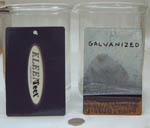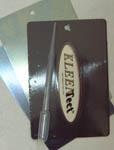- - well if you wanted to design something which corrodes steel as fast as possible you would probably want to have a cocktail like this:
- Ground up rocks, minerals and ores for a good coarse abrasive effect. If possible ground up iron ore aka - ferrous oxide, aka - rust , for a nice `starter' effect.
- Strongly acid soil, say....... ph 3.1 to 4.5 (Did you know that all the mountain, hill and moorland areas in England and Wales have strongly acid soils?)
- Or why not go to the other extreme and have an alkali soil? Alkali can be just as corrosive as acid. If you are going to go for alkali you probably want to go for clay (clay soils are usually alkali) as well just so it clings ferociously. That way each time you go out in the wet that dried on clay can get wet again and take forever to dry out - so the rust worms are nicely fed with the moisture which they need to do their best work.
- To give the cocktail a bit more `zing' and speed things up how about some enzymes in dung and ammonia from fertilizer. Throw in some decaying organic material to keep the soil well aerated and give the rust worms plenty of oxygen.
- To top things off nicely you would probably want to add some salt from Winter roads to really get things moving.
- These maps will show you what you are up against:
- Map of soil ph in UK - click here
- Map of clay content in UK - click here
- Map of most aggressive soils in the UK - click here
- Only KLEENtect can stand up to this cocktail:
Why is mud/clay/chalk soil etc. so corrosive?
First Battery acid then caustic soda (alkali) and then salt do not even affect the gloss finish on this KLEENtect panel
-

- Click on image to see larger image
- A KLEENtect coated panel and a galvanized panel were subjected to this extreme test with the results shown above. They were first dipped in an inch of battery acid for 20 minutes (ph 1) then rinsed in cold water. They were then left in an inch of caustic soda (alkali) solution (ph24) overnight then rinsed in cold water. They were then left in salt water for ten minutes then left for a day. Result: The KLEENtect panel was totally unmarked (KLEENtect contains PTFE which is impervious to acid and alkali attack) The galvanized panel was completely stripped of its zinc coating and is rusting badly.
- You can do a safe and easy version of this test yourself:
- You can do a safe version of this test at home. We can supply an easy and safe to use KLEENtect test panel kit. For safety and convenience's sake instead of a beaker of acid we give you a bulb and pipette to put just a drop of acid or caustic soda on the panel. ( Use the pipette to take a couple of drops from your own battery. Or why not devise your own tests?. KLEENtect will pass any test you devise with flying colours. To get your test kit of a KLEENtect test panel, bulb pipette and instructions send an addressed label and a cheque for £10 to: Chris Parkinson, Before 'n' After, 87 West, New Greenham Park, Newbury, Berks, RG19 6HN
-
